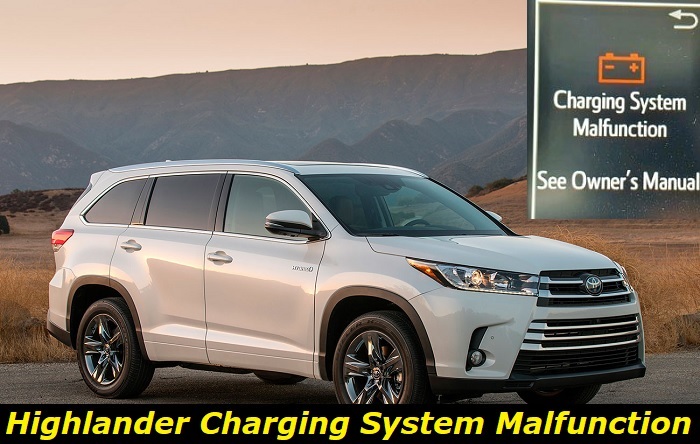Toyota Highlander is a mid-size SUV that has been in the market for quite some time now. Toyota offers this car in eleven trims, giving the buyer a lot to choose from. You can pick Hybrid, non-hybrid, all-wheel, or front-wheel drive. The one thing that stands out in the Toyota Highlander is the smooth handling and the nicely equipped interior.
Charging system malfunction message highlights
- Common reasons:alternator, voltage regulator, battery, or wiring problems
- How to fix:check the voltage in various scenarios
- Possible consequences:car may refuse to start eventually
- Priority level:High
- Can you drive?Yes
- DIY repair:Possible, but complicated
- Repair price range:$150-$800

Charging System Malfunction
When the charging system of Highlander is experiencing a problem, a 'charging system malfunction' errors appears. Given how critical this system is to the car's overall performance, it is essential to have your vehicle checked.
The charging system malfunction error warns the driver that there is an issue with the car's charging system. There won't be another warning indicator that the vehicle has a charging system problem. Let us explore the main reasons why your car can give a charging system malfunction error. This message will appear on the dash along with the battery light.
Reasons for charging system malfunction
- When the key is ON, but the engine is off
This is one of the leading reasons why the charging system malfunction light turns on. This happens either due to ignorance or forgetting the key in the ON position. You might forget to turn OFF the car completely, and if this stays for many hours, the battery is drained because it is not being recharged.
This problem will arise if you listen to music or operate the wipers and the AC when the key is in the ON position for a long time.
- Loose or corroded wiring
If the connection to the battery terminals is faulty, the charging system will not function properly. Loose connectors or faulty wiring will mean the battery is not getting charged by the alternator properly. This leads to low voltage in the battery, which will then be unable to power your car when you want to start it again.
A blown fuse can also bring about a wiring issue. A blown fuse means the current is not flowing as intended, which can bring about a lot of issues to the charging system.
- Bad battery
Whenever a car fails to start, many drivers first check whether the battery is wired right or if it has enough charge. Batteries have expiry dates, and when this happens, such a battery will not be able to start the car or even get charged by the alternator. The Toyota charging system can pick up such a fault with the battery.
- A bad alternator
The alternator is a crucial component of your car's engine. It is designed to harness all the mechanical energy under the hood and convert it into electrical energy. While the battery is the powerhouse for the car, the alternator is the generator through which the battery can power the vehicle. A faulty alternator can cause all sorts of problems. The charging system malfunctioning light will warn you of any alternator issue.
The simplest way to know whether you have a faulty alternator is to check the battery's voltage. The voltage reading should be 13.8V or above when the car is turned on.
- A faulty sensor
Like most modern cars, the Toyota Highlander uses many sensors to operate properly. Even when the battery and the alternator perform optimally, the charging system malfunctioning light can still turn on. The problem can be in a sensor or a fuse, and the charging system has no way of pinpointing this. All it will show you is the light on the dash.
- Faulty alternator belts
The mechanical energy from the engine is converted into electrical energy by the alternator and the conversion starts with the alternator belts. The belts could be faulty, and they may be slipping when driving the alternator or from the engine end. The belts might be rotating at a slower speed than required, making the alternator unable to charge the battery optimally.
Correcting the charging system malfunction issue
As discussed above, several factors can lead to the charging system malfunction in your Toyota Highlander. Here are the various ways you can correct this problem:
- Wiring test
If you check the battery and all is fine, but the charging system malfunction is still on, reconnect the battery. This will force the onboard computer to reset, and the light should disappear. The light will fail to go away if the issue is more complicated. You should seek help at your local Toyota service center. If you notice any frayed or corroded wires, replace them immediately. Tighten loose alternator connectors too.
- The alternator
A faulty alternator will almost always mean a stalled car. There are several remedies available for a defective alternator. However, if the damage is extensive, then you will need to replace it. Installing a new alternator is pretty basic for an experienced mechanic.
It would be best if you caught a failing alternator in time because it can cause a lot of damage. Besides being forced to replace the battery, other components can get damaged due to a faulty alternator.
- The battery
When the battery is drained, you will need to charge it by starting the car. The battery will be fully charged after going for a short drive or when the vehicle is in parking mode. There are times when the battery charge is too low that the engine won't start. This requires recharging the battery to enable it to power the starter. If the battery has reached the end of life, then replacing it is the solution.
- The sensor
The process of identifying a faulty sensor can be arduous. After confirming that the alternator and the battery are working alright, you will need to test every sensor in the charging system.
There are instances when a damaged sensor will have a ripple effect, which is why your mechanic should test all the sensors. They should also establish why the sensor got damaged in the first place to prevent a reoccurrence of the same.
- The alternator belts
When it is established that the alternator belts are faulty, you should check whether the alternator has been set right. This will set the right tension to the belts. In case the belts are worn out, replace them. The alternator belts are not expensive.
How to prevent charging system malfunction problem
Yes, preventing your car from developing a charging system malfunction in your Toyota Highlander is possible. Knowing what to check on your car's charging system will not only help you enjoy your drives, but the car will last longer without developing issues. Regular checks can also save you a lot of money. Here are some of the tricks that will help you;
- Inspect the alternator and the belts - Regularly visually check whether there is anything broken. A torn belt or a cracked component. Also, check whether the alternator is correctly screwed in place. Check that the connectors and cables are not corroded and are tight.
- Check the battery - As indicated earlier, a faulty battery will give rise to a charging system malfunction warning. Regularly check for visual damage to the battery casing, dripping fluids, and loose terminals.
- Check the charging system - This process requires some expertise. The process requires taking readings using a voltmeter. To test the charging system, you will need to check the alternator, the battery, and the voltage regulator. As stated earlier, a stationary car should give a reading of 12V. When started, the voltage should be 13.8V or more. Lower voltage readings in both cases should be addressed by checking all the charging system components.
Conclusion
After reading this article, you are now better at knowing what could be wrong if the charging system malfunction light appears on your dashboard. By understanding some basic features of your car, you will be able to prevent or detect the source of charging system malfunction. Learn to open the hood and look at the various parts of the car; this way, you will be able to note when there is a leak or something is broken.
The charging system malfunction light in your Highlander is helpful in that it prevents the generalization of all electrical faults in your car. This light directs you to check specific areas and components such as the alternator, belts, fuses, and battery. In older cars, an electrical fault means you should check everything from the rear lights, the radio, fuses, and every other electrical part before locating where the problem is.
About the authors
The CarAraC research team is composed of seasoned auto mechanics and automotive industry professionals, including individuals with advanced degrees and certifications in their field. Our team members boast prestigious credentials, reflecting their extensive knowledge and skills. These qualifications include: IMI: Institute of the Motor Industry, ASE-Certified Master Automobile Technicians; Coventry University, Graduate of MA in Automotive Journalism; Politecnico di Torino, Italy, MS Automotive Engineering; Ss. Cyril and Methodius University in Skopje, Mechanical University in Skopje; TOC Automotive College; DHA Suffa University, Department of Mechanical Engineering






Add comment